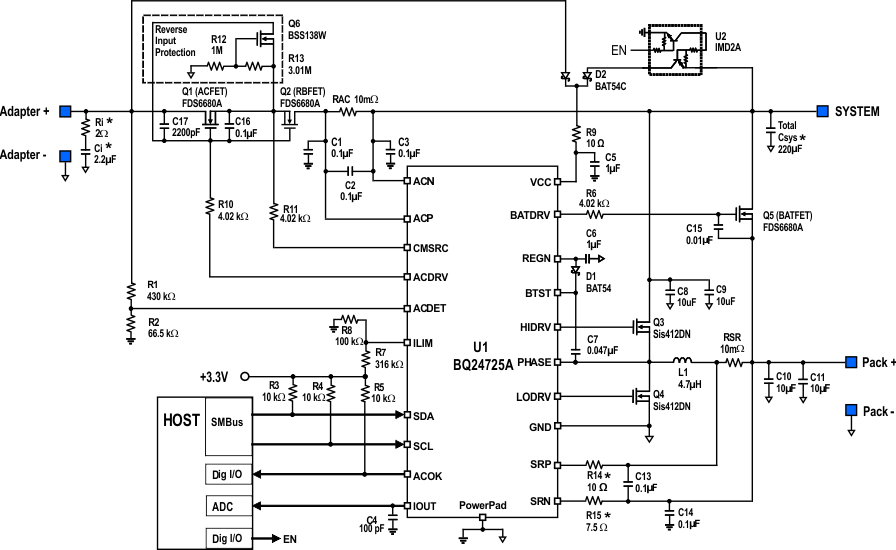JAJSGI6C September 2011 – January 2020 BQ24725A
PRODUCTION DATA.
- 1 特長
- 2 アプリケーション
- 3 概要
- 4 改訂履歴
- 5 Pin Configuration and Functions
- 6 Specifications
- 7 Parameter Measurement Information
-
8 Detailed Description
- 8.1 Overview
- 8.2 Functional Block Diagram
- 8.3 Feature Description
- 8.4
Device Functional Modes
- 8.4.1 Adapter Detect and ACOK Output
- 8.4.2 Adapter Over Voltage (ACOVP)
- 8.4.3 System Power Selection
- 8.4.4 Battery LEARN Cycle
- 8.4.5 Enable and Disable Charging
- 8.4.6 Automatic Internal Soft-Start Charger Current
- 8.4.7 High Accuracy Current Sense Amplifier
- 8.4.8 Charge Timeout
- 8.4.9 Converter Operation
- 8.4.10 Continuous Conduction Mode (CCM)
- 8.4.11 Discontinuous Conduction Mode (DCM)
- 8.4.12 Input Over Current Protection (ACOC)
- 8.4.13 Charge Over Current Protection (CHGOCP)
- 8.4.14 Battery Over Voltage Protection (BATOVP)
- 8.4.15 Battery Shorted to Ground (BATLOWV)
- 8.4.16 Thermal Shutdown Protection (TSHUT)
- 8.4.17 EMI Switching Frequency Adjust
- 8.4.18 Inductor Short, MOSFET Short Protection
- 8.5 Register Maps
-
9 Application and Implementation
- 9.1 Application Information
- 9.2
Typical Applications
- 9.2.1
Typical System with Two NMOS Selector
- 9.2.1.1 Design Requirements
- 9.2.1.2
Detailed Design Procedure
- 9.2.1.2.1 Negative Output Voltage Protection
- 9.2.1.2.2 Reverse Input Voltage Protection
- 9.2.1.2.3 Reduce Battery Quiescent Current
- 9.2.1.2.4 Inductor Selection
- 9.2.1.2.5 Input Capacitor
- 9.2.1.2.6 Output Capacitor
- 9.2.1.2.7 Power MOSFETs Selection
- 9.2.1.2.8 Input Filter Design
- 9.2.1.2.9 BQ24725A Design Guideline
- 9.2.1.3 Application Curves
- 9.2.2 Simplified System without Power Path
- 9.2.1
Typical System with Two NMOS Selector
- 9.3 System Examples
- 10Power Supply Recommendations
- 11Layout
- 12デバイスおよびドキュメントのサポート
- 13メカニカル、パッケージ、および注文情報
パッケージ・オプション
メカニカル・データ(パッケージ|ピン)
- RGR|20
サーマルパッド・メカニカル・データ
- RGR|20
発注情報
9.2.1 Typical System with Two NMOS Selector
BQ24725A is SMBus controlled customizable charge controller, and can be configured for automatic system power source selection, by utilizing two charge pumps to separately drive n-channel MOSFETs (ACFET, RBFET and BATFET). BQ24725A automatically switches adapter or battery power to system. An automatic break-before-make logic prevents shoot-through currents when the selectors switch.

Fs = 750kHz, IADPT = 4.096A, ICHRG = 2.944A, ILIM = 4A, VCHRG = 12.592V, 90W adapter and 3S2P battery pack
Use 0Ω for better current sensing accuracy, use 10Ω/7.5Ω resistor for reversely battery connection protection. See application information about negative output voltage protection for hard shorts on battery to ground or battery reversely connection.
The total Csys is the lump sum of system capacitance. It is not required by charger IC. Use Ri and Ci for adapter hot plug-in voltage spike damping. See application information about input filter design.
Figure 18. Typical System Schematic with Two NMOS Selector Table 7. Component List for Typical System Circuit of Figure 18
| PART DESIGNATOR | QTY | DESCRIPTION |
|---|---|---|
| C1, C2, C3, C13, C14, C16 | 6 | Capacitor, Ceramic, 0.1µF, 25V, 10%, X7R, 0603 |
| C4 | 1 | Capacitor, Ceramic, 100pF, 25V, 10%, X7R, 0603 |
| C5, C6 | 2 | Capacitor, Ceramic, 1µF, 25V, 10%, X7R, 0603 |
| C7 | 1 | Capacitor, Ceramic, 0.047µF, 25V, 10%, X7R, 0603 |
| C8, C9, C10, C11 | 4 | Capacitor, Ceramic, 10µF, 25V, 10%, X7R, 1206 |
| C15 | 1 | Capacitor, Ceramic, 0.01µF, 25V, 10%, X7R, 0603 |
| C17 | 1 | Capacitor, Ceramic, 2200pF, 25V, 10%, X7R, 0603 |
| Ci | 1 | Capacitor, Ceramic, 2.2µF, 25V, 10%, X7R, 1210 |
| Csys | 1 | Capacitor, Electrolytic, 220µF, 25V |
| D1 | 1 | Diode, Schottky, 30V, 200mA, SOT-23, Fairchild, BAT54 |
| D2 | 1 | Diode, Dual Schottky, 30V, 200mA, SOT-23, Fairchild, BAT54C |
| Q1, Q2, Q5 | 3 | N-channel MOSFET, 30V, 12.5A, SO-8, Fairchild, FDS6680A |
| Q3, Q4 | 2 | N-channel MOSFET, 30V, 12A, PowerPAK 1212-8, Vishay Siliconix, SiS412DN |
| Q6 | 1 | N-channel MOSFET, 50V, 0.2A, SOT-323, Diodes, BSS138W |
| L1 | 1 | Inductor, SMT, 4.7µH, 5.5A, Vishay Dale, IHLP2525CZER4R7M01 |
| R1 | 1 | Resistor, Chip, 430kΩ, 1/10W, 1%, 0603 |
| R2 | 1 | Resistor, Chip, 66.5kΩ, 1/10W, 1%, 0603 |
| R3, R4, R5 | 3 | Resistor, Chip, 10kΩ, 1/10W, 1%, 0603 |
| R6, R10, R11 | 3 | Resistor, Chip, 4.02kΩ, 1/10W, 1%, 0603 |
| R7 | 1 | Resistor, Chip, 316kΩ, 1/10W, 1%, 0603 |
| R8 | 1 | Resistor, Chip, 100kΩ, 1/10W, 1%, 0603 |
| R9 | 1 | Resistor, Chip, 10Ω, 1/4W, 1%, 1206 |
| R12 | 1 | Resistor, Chip, 1.00MΩ, 1/10W, 1%, 0603 |
| R13 | 1 | Resistor, Chip, 3.01MΩ, 1/10W, 1%, 0603 |
| R14 | 1 | Resistor, Chip, 10Ω, 1/10W, 5%, 0603 |
| R15 | 1 | Resistor, Chip, 7.5Ω, 1/10W, 5%, 0603 |
| RAC, RSR | 2 | Resistor, Chip, 0.01Ω, 1/2W, 1%, 1206 |
| Ri | 1 | Resistor, Chip, 2Ω, 1/2W, 1%, 1210 |
| U1 | 1 | Charger controller, 20 pin VQFN, TI, BQ24725ARGR |
| U2 | 1 | Dual digital transistor, 40V, 30mA, SC-74, Rohm, IMD2A |